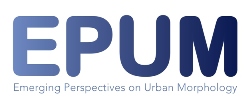The EPUM consortium developed an array of resources providing content for the open learning curriculum (O1) and the online training tools (O3). Some of the resources are collated from existing sources while others are developed for the project.
The resources are designed to match the needs of the curriculum and to fit into the learning structure, as well as to work as stand-alone resources for use in existing educational modules. The aim is to capitalize on expertise and subject-specific knowledge generated by all participants at different domains: urban form theoretical framework, urban form methods of analysis, public spaces, spatial configuration and social phenomena, and empirical studies.
Furthermore, it is envisaged that the resources cover a wide range of formats and representations to meet educational standards and address the needs of different learning styles.
Learning resources on different approaches and complementary resources
This section presents a number of open-access, English-language, resources (existing and new) that are fundamental to present each of the approaches promoted in the EPUM project: the historico-geographical approach, the process-typological approach, space syntax and the relational-material approach. In addition, it gathers a number of complementary resources that can be used to describe and explain the physical form of cities.
Table 1 lists 43 resources. The list is in five parts.
The first part is on the historico-geographical approach. Resource 1, a short-film, and 2, a briefing paper, were produced for the EPUM project and offer a first introduction to this approach. This introduction is further developed in two interviews to the main proponents of these approaches, MRG Conzen and JWR Whitehand. A synthesis of the approach is offered by a paper (Resource 5), while the website of the Urban Morphology Research Group offers an overview of the recent advances in this approach. Resource 7 explains, in an interactive way, one of the most important concepts of this approach, the morphological region.
The second part is on the process-typological approach. As in the former case, it starts with an introduction to this approach through a short film and a briefing paper. One lecture by Giuseppe Strappa expand the theoretical and methodological dimensions of this morphological approach. Two papers (resources 11 and 12) offer a description of the origins, developments and main characteristics of this approach, highlighting the key role of Saverio Muratori and Gianfranco Caniggia.
The third part is on space syntax. As the first and second parts of this section, it includes a short-film and a briefing paper prepared under the framework of the EPUM project. It also includes a short introductory video on Space Syntax Limited. One fundamental open-access resource gathered here is the book ‘Space is the machine’ that is central for this configurational approach. The other three resources are: an online training platform, a website collecting information on both software and conferences, and the ‘Journal of Space Syntax’.
The fourth part is on the relational-material approach. It includes a short film and a briefing paper of this approach that offers a social perspective on cities, prepared under the framework of the EPUM project. In addition, it presents two additional films and a reader.
The fifth part gathers a number of additional resources for teaching urban morphology. While these are not directly promoted in the EPUM project, they are important elements to describe and explain the physical form of cities as well as the agents and processes that change this physical form over time.
These resources are in three main groups: general, history of urban form (and of planning) and other morphological approaches.
The last part offers some insights on the combination and integration of different approaches. It is made of two videos (recorded in Nicosia and Porto) where the different partners discuss the possibilities for collaboration and of an e-book on the process and results of Porto Intensive Workshop.
LINKS to TABLE 1 and DESCRIPTION OF THE RESOURCES.


